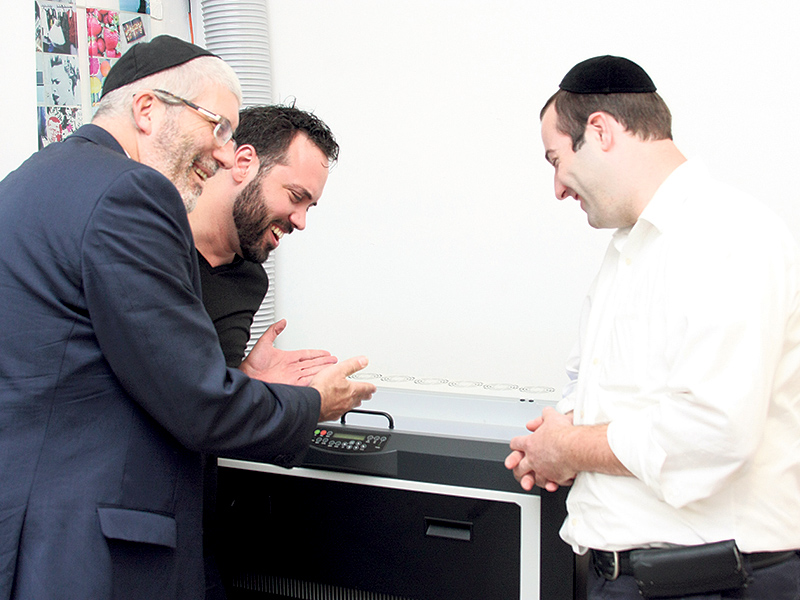How many rabbis does it take to kasher a laser cutter? One, apparently, plus a field representative from the Kashruth Council of Canada (COR).
The age-old question was answered earlier this month when Rabbi Mendel Brogna, head mashgiach of COR’s food service division, and his colleague Chaim Ribiat, a junior software developer, visited MakeLab, an interactive design studio in downtown Toronto, to ascertain whether the laser cutter in MakeLab’s rentable “edible selfie photo booth” could be made kosher for an upcoming event.
The answer was that the laser itself was already kosher, but some halachic tinkering was necessary.
MakeLab, which creates unique technology products that incorporate tools such as 3D printers and laser cutters with responsive or wearable design, is typically hired to run interactive experiences at corporate or private events.
Its products range from a 3D printing nail bar to a giant digital colouring book.
“Our competition tends to be photo booths and chocolate fountains. If a client really wants to impress, they come to us for 3D stuff,” said Jonathan Moneta, MakeLab’s founder and creative director.
The studio was recently contacted by a kosher caterer interested in featuring the edible selfie booth at a kosher conference she’s organizing for next year.
She wanted to know if it was possible to “do this kosher,” Moneta said.
READ: WHAT’S A KOSHER FOODIE TO DO?
The booth lets people get their photograph taken and then uses a laser cutter to caramelize the images on the spot into cookies, macaroons and cupcakes.
Moneta, who grew up Reform in North York and previously worked as co-ordinator for the Jewish learning festival Limmud Toronto, said he told the caterer she could use kosher cookies, but as for making the laser cutter kosher, he was out of his depth.
“She contacted COR and they sent over an Orthodox rabbi to check it out,” he said.
Rabbi Brogna and Ribiat arrived at the studio and set to work learning everything they could about the laser.
“They debated with each other… asking questions like what part of the cookie touches the laser cutter? Does the laser cutter get hot? I suspect they were trying to figure out whether to categorize the laser cutter as an oven, because an oven is kashered a certain way,” Moneta recounted.
The COR representatives were also concerned with whether any off-gassing from the process gets cycled back into the device’s chamber (it doesn’t) and what surface the cookie sits on.
Rabbi Brogna told The CJN that examining the laser was “a fascinating experience.”
He concluded that because the laser makes no physical contact with the items being caramelized, “no kashering was needed.” His only stipulation was that a special plate be purchased for the kosher pastry to rest on.
“They asked me if the business is Jewish-owned. It is. Because of that, they required that a non-Jewish person buy the plate on which the cookie sits… We decided that our events lead Alyssa Janzen will own it,” Moneta said, adding that he was asked to send COR a formal contract declaring Janzen owns the plate.
“They don’t fool around man,” Moneta chuckled.
Rabbi Brogna said that if a Jewish person owned the plate, it would have to be taken to a mikvah before being used, so it was less hassle to have a non-Jew buy it.
“Rabbis are always working hard to adapt modern technology to ensure it doesn’t compromise authentic Judaism,” he told The CJN.
Moneta described the entire experience as fascinating and “bizarre,” noting it sparked “really interesting conversations about Jewish law” among his colleagues.
“On one hand, this experience was hilarious, but on another, to think that [the rabbi] was drawing on millennia of Jewish thought to confront the challenge of new technology… I find that heartwarming and beautiful,” he said.
